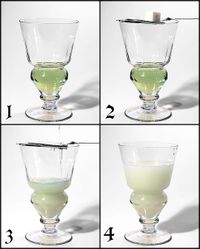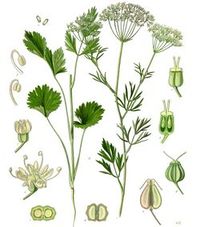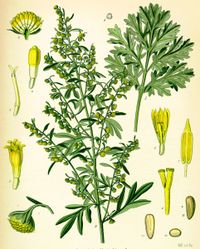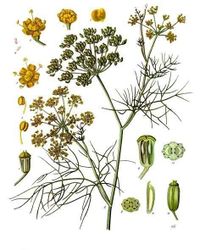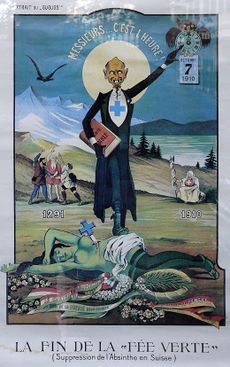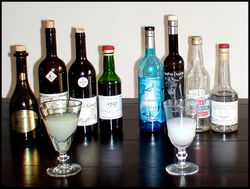أبسنت

الأبسنت أو الأفسنتين أو شراب الشيح بالإنجليزية Absinthe ، هو شراب كحولي بنكهة الينسون شديد العرق (أي ذو محتوى الكحولي عالي (45%-70%)) مقطـَّر مستخرج من الأعشاب, وخاصة زهور وأوراق الشيح الرومي Artemisia absinthium, و“الشيح wormwood عموماً.” والأبسنت في المعتاد لونه أخضر إلا أنه يـُنتج كذلك شفافاً أو يـُصبـَغ اصطناعياً. وكثراً ما يـُسـَمى “الجنية الخضراء the Green Fairy.” يستعمل في الطب للهضم والايلاع والحميات والإدرار وطرد الدود، وذلك بالإضافة لكونه مشروباً روحياً.
روح الشيح يجب ألا يـُشرَب على الإطلاق.
"الطقوس" (إعداده)
الإنتاج
The three main herbs used to produce absinthe are grande wormwood, green anise, and florence fennel, which are often called "the holy trinity."[1] Many other herbs may be used as well, such as petite wormwood (Artemisia pontica or Roman wormwood), hyssop, melissa, star anise, angelica root, Sweet Flag, dittany leaves, coriander, veronica, juniper, جوزة الطيب, and various mountain herbs.
Modern absinthe is often produced by mixing steam-distilled oils in high-proof alcohol, and is called an oil-mix.
NOTE: Absinthe can also be naturally colored red using hibiscus flowers. This is called a rouge or rose absinthe. As of now, only one historical rouge brand has been discovered[2].
الأنماط
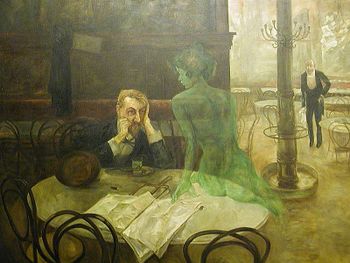
تاريخ
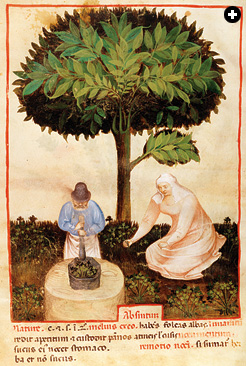
من المعرفة، الموسوعة الحرة لجمع المحتوى العربي
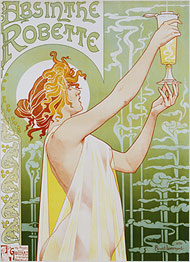
الأصل
أصل الأبسنت على وجه التحديد غير معروف. ويعود الاستخدام الطبي للشيح إلى مصر القديمة وهو مذكور في بردية إبرز، حوالي سنة 1550 ق.م. مستخلص الشيح وأوراق الشيح المغموسة في النبيذ استعملها قدامى الإغريق كعلاج. وبالإضافة لذلك, هناك أدلة على وجود نبيذ بنكهة الشيح, absinthites oinos, في اليونان القديمة.[3]
النمو السريع في الإستهلاك الفرنسي
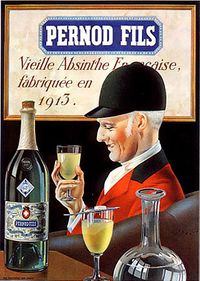
الحظر
Spurred by the temperance movement and wine makers' associations, absinthe was publicly associated with violent crimes and social disorder.
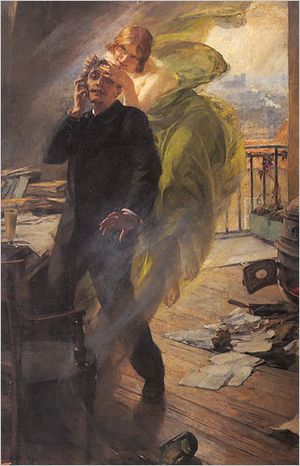
وقد قال ناقد:
Absinthe makes you crazy and criminal, provokes epilepsy and tuberculosis, and has killed thousands of French people. It makes a ferocious beast of man, a martyr of woman, and a degenerate of the infant, it disorganizes and ruins the family and menaces the future of the country.[4]
Edgar Degas’ 1876 painting L’Absinthe ("Absinthe") (now at the Musée d’Orsay) epitomized the popular view of absinthe 'addicts' as sodden and benumbed. Although he mentioned it only once by name, Émile Zola described their serious intoxication in his novel L’Assommoir:
Boche had known a joiner who had stripped himself stark naked in the rue Saint-Martin and died doing the polka—he was an absinthe-drinker.[5]
In Switzerland, the ban drove absinthe underground. Evidence suggests small home clandestine distillers have been producing absinthe after the ban, focusing on Les Blanches or Les Bleues as it was easier to disguise a clear product as non-absinthe.
Many countries never banned absinthe, notably Britain, where absinthe had not been as popular as in mainland Europe.
الإحياء المعاصر
الوقع الثقافي
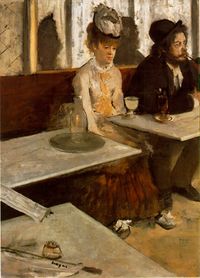
تأثير الأبسنت
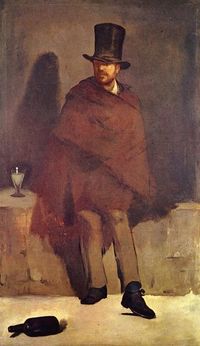
المصادر
- Adams, Jad. "Hideous Absinthe: A History of the Devil in a Bottle." Tauris Parke Paperbacks: 2008. ISBN: 1-84511-684-4.
- Hutton, Ian (September 2002). "Myth, Reality and Absinthe" (pdf). Republished by Thomson Scientific."− Myth, Reality and Absinthe" (html).
- "Oxygénée's Absinthe History & FAQ III". Absinthe FAQ at The Virtual Absinthe Museum: History and Origins of Absinthe. Oxygenee Ltd. 2007. Retrieved 2007-11-30.
{{cite web}}: External link in|work=
هامش
- ^ Chu, Louisa (March 12, 2008). "Crazy for absinthe". Chicago Tribune online.
{{cite news}}: Italic or bold markup not allowed in:|publisher=(help) - ^ Original Vintage Absinthe Posters at The Virtual Absinthe Museum: Tamagno, Privat-Livemont
- ^ Apsinthitês oinos: Henry George Liddell, Robert Scott, A Greek-English Lexicon
- ^ Conrad III, Barnaby; (1988). Absinthe History in a Bottle. Chronicle books. ISBN 0-8118-1650-8 Pg. 116
- ^ page 411 of the 1970 Penguin Classics English edition
- تحوي هذه المقالة معلومات مترجمة من الطبعة الحادية عشرة لدائرة المعارف البريطانية لسنة 1911 وهي الآن من ضمن الملكية العامة.
وصلات خارجية
- The Virtual Absinthe Museum — An online museum of absinthe history, lore, art and antiques.
- La Fée Verte — An online user forum and absinthe guide with user reviews and a reference library of absinthe-related articles.
- Absinthe.com.au — An Australian-based absinthe information, culture and review site featuring research on the history of absinthe in Australia.
- Wormwood Symposium — An absinthe testing blog with guide of on-topic articles.
- The Wormwood Society — An independent organization supporting changes to the U.S. laws and regulations concerning absinthe. Provides articles, a forum and legal information.
- Artemisia absinthium references from the Biodiversity Heritage Library
- Artemisia pontica references from the Biodiversity Heritage Library
- Rothstein, Edward. "Absinthe Returns in a Glass Half Full of Mystique and Misery", New York Times November 12, 2007 accessed November 12, 2007
- Absinthe.se — A collection of absinthe reviews and information.
- Thujone.info - A data bank of peer-reviewed articles on thujone, absinthe, and absinthism, with independent thujone ratings of some commercial brands.
- "A Liquor of Legend Makes a Comeback", New York Times, December 5, 2007 - accessed December 5, 2007.
- absintheology.com
مقالات
- Arnaud Van De Casteele "L'absinthe" in Andrieu et Boëtsch Le dictionnaire du Corps, Paris, éditions CNRS, 2008.
- Arnaud Van De Casteele "L'absinthe, le suc de la montagne" in Boëtsch et Hubert L'Alimentation en montagne, Gap, éditions des Hautes-Alpes, 2007.
- Absinthe’s second coming — An April 2001 article in Cigar Aficionado about the first absinthe commercially produced in France since the 1915 ban.
- Swiss face sobering future after legalizing absinthe — A March 2005 Reuters article about the legalization of absinthe in Switzerland.
- The Mystery of the Green Menace — A November 2005 WIRED Magazine article about a New Orleans man who has researched the chemical content of Absinthe and now distills it in France.
- The Return of the Green Faerie — A wine and spirit journal article about the history, ritual, and artistic cult of Absinthe.
- Turner, Jack "Green Gold: The return of absinthe". The New Yorker (March 13 2006):38–44.
- Absinthe - Demystifying the Storied Drink — An April 2006 Associated Press/asap Flash interactive, multimedia piece about absinthe.
- Barely Legal: American Absinthe Passes the Taste Test — Wired magazine article reviews Lucid.
- Absinthism: A fictitious 19th century syndrome with present impact Padosch, S.A., Lachenmeier, D.W., and Kroener, L.U. Substance Abuse Treatment, Prevention, and Policy 2006, 1:14.
- [1] - MacLean’s Article December 17th 2007
- Chemical Composition of Vintage Preban Absinthe with Special Reference to Thujone, Fenchone, Pinocamphone, Methanol, Copper, and Antimony Concentrations Dirk W. Lachenmeier, David Nathan-Maister, Theodore A. Breaux, Eva-Maria Sohnius, Kerstin Schoeberl, and Thomas Kuballa. Journal of Agricultural and Food Chemistry (2008).
